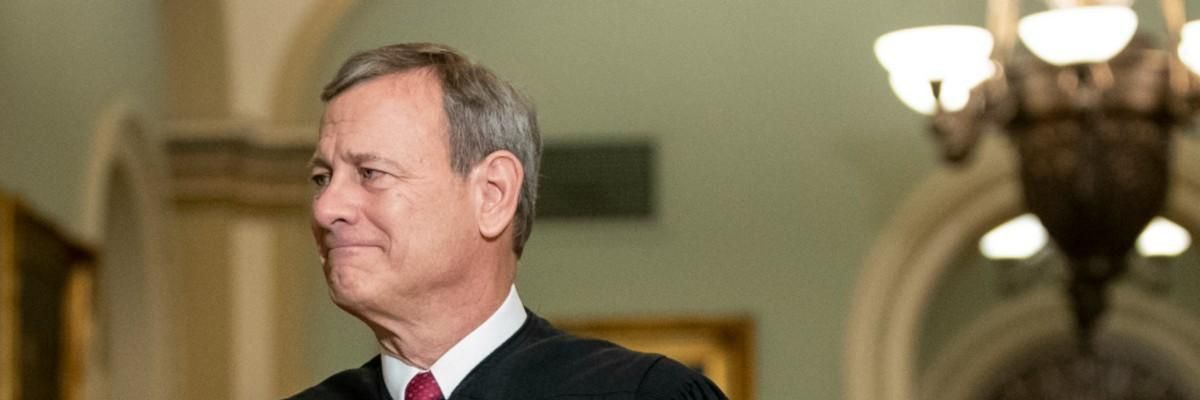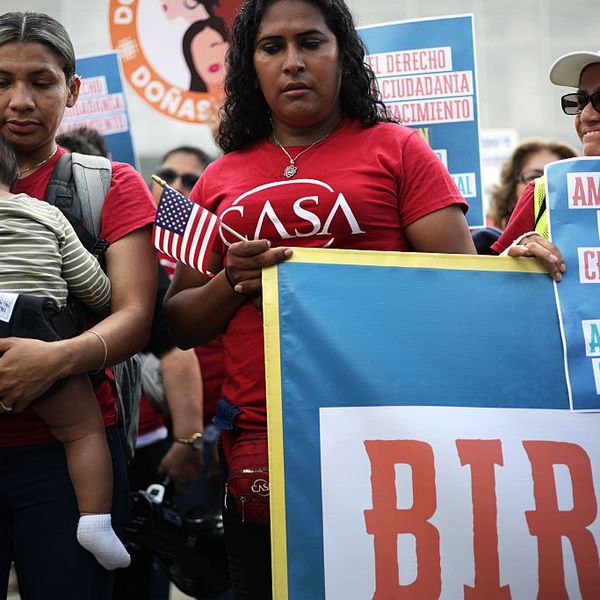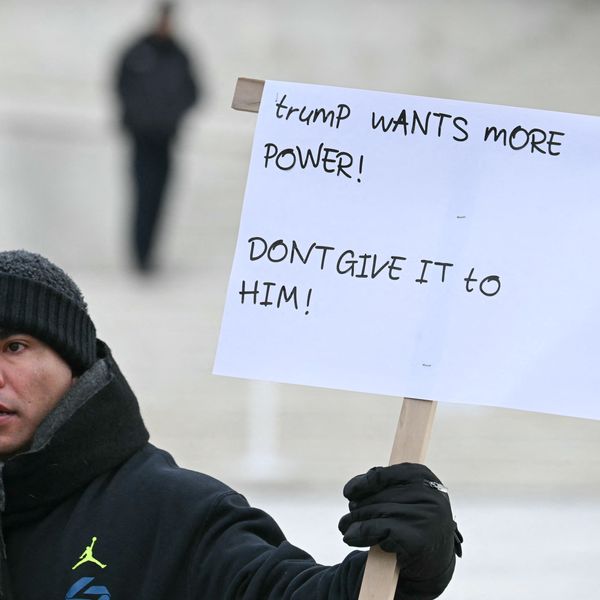
Supreme Court Chief Justice John Roberts arrives to the Senate chamber for impeachment proceedings at the U.S. Capitol on January 16, 2020 in Washington, DC. (Photo: Drew Angerer/Getty Images)
The Supreme Court's Legitimacy Crisis
Last term, the justices showed little concern for the public's trust in them.
Chief Justice John Roberts said at an event last week that he doesn't understand current questions about the Supreme Court's legitimacy. "The [Court's] decisions have always been publicly criticized," the chief justice said, but it is a "mistake" to view those critiques as questioning the Court's legitimacy so long as the Court keeps doing its job, which is "to say what the law is."
To preserve the Court's legitimacy as an institution that differs from the elected branches, the justices have to appear willing to sometimes "say what the law is" in ways that do not serve their personal or partisan preferences.
But is the Supreme Court actually doing its job? Courts are supposed to operate under rules and norms that discourage overreach and encourage public confidence. By deciding questions it doesn't have to, making major decisions via unexplained orders, and tainting key rulings with ethical lapses, last term's decisions give the public reason to think the Court is not saying what the law is, but what the justices personally prefer it to be.
In Roberts's concurring opinion in Dobbs v. Jackson Women's Health Organization, which took away the right to abortion, he wrote that "if it is not necessary to decide more to dispose of a case, then it is necessary not to decide more." Yet on numerous occasions last term, the Court did just that, answering questions it was not asked on the way to fulfilling long-standing conservative policy goals in ways that make the justices look much more like players in the game than referees.
In Dobbs, for example, Mississippi first told the Court it could uphold both Roe v. Wade and the state's abortion ban. Mississippi only changed its argument after Justice Amy Coney Barrett replaced Justice Ruth Bader Ginsburg, and the new Court majority embraced this gambit. And in West Virginia v. Environmental Protection Agency, the Court gutted the ability of the EPA and other federal agencies to do their jobs by ruling on a Clean Power Plan the Biden administration had already said it had no intentions of putting into effect.
If one way that judges enhance their legitimacy is by "render[ing] judgments through written opinions that explain their reasoning," as the chief justice has said, then it is worth noting that many of the Court's most significant decisions last term came via unsigned orders with little to no explanation. The Court used its "shadow docket" to reverse lower courts' decisions about redistricting, pandemic mandates, and abortion access in ways that furthered conservative or Republican interests without full briefing, oral argument, or much reason for the public to understand the decisions as motivated by anything but partisanship.
It also doesn't help the Court's legitimacy that high-profile decisions were tainted by major ethical lapses. In January, the Supreme Court decided a case about the release of White House communications related to the January 6 insurrection. Justice Clarence Thomas issued the lone dissent in that case, which the public found out months later likely involved text messages from his wife, Ginni Thomas. (Through this incident, the public was once again reminded that the Supreme Court is the only court in the country without an ethics code, even though it is within the justices' power to adopt one.)
And of course, even if the Court shouldn't always feel bound by public opinion, the public's perceptions of the Court depend in part on whether it agrees with the justices' decisions. Researchers have found this to be true, which may be why the Court's understanding of the law throughout its history has generally evolved along with public opinion. This history makes it even more striking that a decade-long survey found the Court, which had been largely in step with public opinion, has veered significantly to the right and out of step with the public in the two years since the Court's composition changed.
As Justice Elena Kagan said in her public appearances this week, "Judges create legitimacy problems for themselves when they don't act like courts" and "when they instead stray into places that look like politics." The Court's decisions and tactics last term look a whole lot like politics in robes.
This is a shame because the legitimacy of the Court matters. The Court does not have budgetary power or military might like the other branches--it has the public's trust and the public's expectation that those other branches will follow Court decisions. When the public perceives the Court's decisions as legitimate, it puts pressure on elected officials to follow those decisions even when they disagree with them.
To preserve the Court's legitimacy as an institution that differs from the elected branches, the justices have to appear willing to sometimes "say what the law is" in ways that do not serve their personal or partisan preferences. This past term, however, showcased a Supreme Court majority unwilling to do so, legitimacy be damned.
An Urgent Message From Our Co-Founder
Dear Common Dreams reader, The U.S. is on a fast track to authoritarianism like nothing I've ever seen. Meanwhile, corporate news outlets are utterly capitulating to Trump, twisting their coverage to avoid drawing his ire while lining up to stuff cash in his pockets. That's why I believe that Common Dreams is doing the best and most consequential reporting that we've ever done. Our small but mighty team is a progressive reporting powerhouse, covering the news every day that the corporate media never will. Our mission has always been simple: To inform. To inspire. And to ignite change for the common good. Now here's the key piece that I want all our readers to understand: None of this would be possible without your financial support. That's not just some fundraising cliche. It's the absolute and literal truth. We don't accept corporate advertising and never will. We don't have a paywall because we don't think people should be blocked from critical news based on their ability to pay. Everything we do is funded by the donations of readers like you. Will you donate now to help power the nonprofit, independent reporting of Common Dreams? Thank you for being a vital member of our community. Together, we can keep independent journalism alive when it’s needed most. - Craig Brown, Co-founder |
Chief Justice John Roberts said at an event last week that he doesn't understand current questions about the Supreme Court's legitimacy. "The [Court's] decisions have always been publicly criticized," the chief justice said, but it is a "mistake" to view those critiques as questioning the Court's legitimacy so long as the Court keeps doing its job, which is "to say what the law is."
To preserve the Court's legitimacy as an institution that differs from the elected branches, the justices have to appear willing to sometimes "say what the law is" in ways that do not serve their personal or partisan preferences.
But is the Supreme Court actually doing its job? Courts are supposed to operate under rules and norms that discourage overreach and encourage public confidence. By deciding questions it doesn't have to, making major decisions via unexplained orders, and tainting key rulings with ethical lapses, last term's decisions give the public reason to think the Court is not saying what the law is, but what the justices personally prefer it to be.
In Roberts's concurring opinion in Dobbs v. Jackson Women's Health Organization, which took away the right to abortion, he wrote that "if it is not necessary to decide more to dispose of a case, then it is necessary not to decide more." Yet on numerous occasions last term, the Court did just that, answering questions it was not asked on the way to fulfilling long-standing conservative policy goals in ways that make the justices look much more like players in the game than referees.
In Dobbs, for example, Mississippi first told the Court it could uphold both Roe v. Wade and the state's abortion ban. Mississippi only changed its argument after Justice Amy Coney Barrett replaced Justice Ruth Bader Ginsburg, and the new Court majority embraced this gambit. And in West Virginia v. Environmental Protection Agency, the Court gutted the ability of the EPA and other federal agencies to do their jobs by ruling on a Clean Power Plan the Biden administration had already said it had no intentions of putting into effect.
If one way that judges enhance their legitimacy is by "render[ing] judgments through written opinions that explain their reasoning," as the chief justice has said, then it is worth noting that many of the Court's most significant decisions last term came via unsigned orders with little to no explanation. The Court used its "shadow docket" to reverse lower courts' decisions about redistricting, pandemic mandates, and abortion access in ways that furthered conservative or Republican interests without full briefing, oral argument, or much reason for the public to understand the decisions as motivated by anything but partisanship.
It also doesn't help the Court's legitimacy that high-profile decisions were tainted by major ethical lapses. In January, the Supreme Court decided a case about the release of White House communications related to the January 6 insurrection. Justice Clarence Thomas issued the lone dissent in that case, which the public found out months later likely involved text messages from his wife, Ginni Thomas. (Through this incident, the public was once again reminded that the Supreme Court is the only court in the country without an ethics code, even though it is within the justices' power to adopt one.)
And of course, even if the Court shouldn't always feel bound by public opinion, the public's perceptions of the Court depend in part on whether it agrees with the justices' decisions. Researchers have found this to be true, which may be why the Court's understanding of the law throughout its history has generally evolved along with public opinion. This history makes it even more striking that a decade-long survey found the Court, which had been largely in step with public opinion, has veered significantly to the right and out of step with the public in the two years since the Court's composition changed.
As Justice Elena Kagan said in her public appearances this week, "Judges create legitimacy problems for themselves when they don't act like courts" and "when they instead stray into places that look like politics." The Court's decisions and tactics last term look a whole lot like politics in robes.
This is a shame because the legitimacy of the Court matters. The Court does not have budgetary power or military might like the other branches--it has the public's trust and the public's expectation that those other branches will follow Court decisions. When the public perceives the Court's decisions as legitimate, it puts pressure on elected officials to follow those decisions even when they disagree with them.
To preserve the Court's legitimacy as an institution that differs from the elected branches, the justices have to appear willing to sometimes "say what the law is" in ways that do not serve their personal or partisan preferences. This past term, however, showcased a Supreme Court majority unwilling to do so, legitimacy be damned.
Chief Justice John Roberts said at an event last week that he doesn't understand current questions about the Supreme Court's legitimacy. "The [Court's] decisions have always been publicly criticized," the chief justice said, but it is a "mistake" to view those critiques as questioning the Court's legitimacy so long as the Court keeps doing its job, which is "to say what the law is."
To preserve the Court's legitimacy as an institution that differs from the elected branches, the justices have to appear willing to sometimes "say what the law is" in ways that do not serve their personal or partisan preferences.
But is the Supreme Court actually doing its job? Courts are supposed to operate under rules and norms that discourage overreach and encourage public confidence. By deciding questions it doesn't have to, making major decisions via unexplained orders, and tainting key rulings with ethical lapses, last term's decisions give the public reason to think the Court is not saying what the law is, but what the justices personally prefer it to be.
In Roberts's concurring opinion in Dobbs v. Jackson Women's Health Organization, which took away the right to abortion, he wrote that "if it is not necessary to decide more to dispose of a case, then it is necessary not to decide more." Yet on numerous occasions last term, the Court did just that, answering questions it was not asked on the way to fulfilling long-standing conservative policy goals in ways that make the justices look much more like players in the game than referees.
In Dobbs, for example, Mississippi first told the Court it could uphold both Roe v. Wade and the state's abortion ban. Mississippi only changed its argument after Justice Amy Coney Barrett replaced Justice Ruth Bader Ginsburg, and the new Court majority embraced this gambit. And in West Virginia v. Environmental Protection Agency, the Court gutted the ability of the EPA and other federal agencies to do their jobs by ruling on a Clean Power Plan the Biden administration had already said it had no intentions of putting into effect.
If one way that judges enhance their legitimacy is by "render[ing] judgments through written opinions that explain their reasoning," as the chief justice has said, then it is worth noting that many of the Court's most significant decisions last term came via unsigned orders with little to no explanation. The Court used its "shadow docket" to reverse lower courts' decisions about redistricting, pandemic mandates, and abortion access in ways that furthered conservative or Republican interests without full briefing, oral argument, or much reason for the public to understand the decisions as motivated by anything but partisanship.
It also doesn't help the Court's legitimacy that high-profile decisions were tainted by major ethical lapses. In January, the Supreme Court decided a case about the release of White House communications related to the January 6 insurrection. Justice Clarence Thomas issued the lone dissent in that case, which the public found out months later likely involved text messages from his wife, Ginni Thomas. (Through this incident, the public was once again reminded that the Supreme Court is the only court in the country without an ethics code, even though it is within the justices' power to adopt one.)
And of course, even if the Court shouldn't always feel bound by public opinion, the public's perceptions of the Court depend in part on whether it agrees with the justices' decisions. Researchers have found this to be true, which may be why the Court's understanding of the law throughout its history has generally evolved along with public opinion. This history makes it even more striking that a decade-long survey found the Court, which had been largely in step with public opinion, has veered significantly to the right and out of step with the public in the two years since the Court's composition changed.
As Justice Elena Kagan said in her public appearances this week, "Judges create legitimacy problems for themselves when they don't act like courts" and "when they instead stray into places that look like politics." The Court's decisions and tactics last term look a whole lot like politics in robes.
This is a shame because the legitimacy of the Court matters. The Court does not have budgetary power or military might like the other branches--it has the public's trust and the public's expectation that those other branches will follow Court decisions. When the public perceives the Court's decisions as legitimate, it puts pressure on elected officials to follow those decisions even when they disagree with them.
To preserve the Court's legitimacy as an institution that differs from the elected branches, the justices have to appear willing to sometimes "say what the law is" in ways that do not serve their personal or partisan preferences. This past term, however, showcased a Supreme Court majority unwilling to do so, legitimacy be damned.

